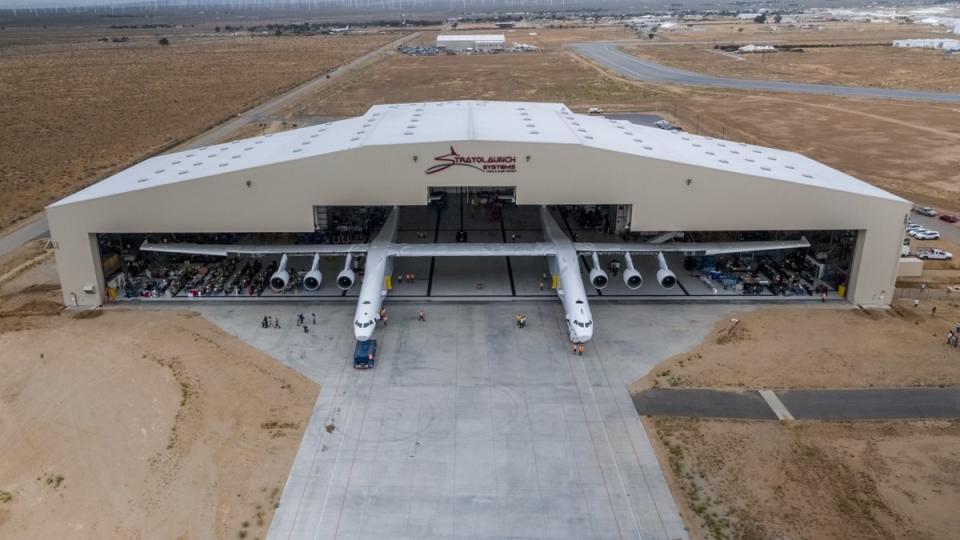Is This the Beginning of the End for Stratolaunch?
73 meters in length and with a wingspan of 117 meters, Stratolaunch Systems' rocket-carrying aircraft Roc is -- by some measures at least -- the largest airplane ever built.
That didn't happen by accident. Roc was purpose-built to do just one thing: carry rockets to an altitude of 35,000 feet, where Earth's atmosphere is thin and rockets fly fast, then release those rockets to blast their way into orbit. Stratolaunch hoped to use Roc to lower the cost of spaceflight.
Billionaire Paul Allen, a cofounder of Microsoft along with Bill Gates, financed Roc's construction. Scaled Composites, now a subsidiary of Northrop Grumman (NYSE: NOC), built it...and it's starting to look as if Northrop Grumman's rockets are the only rockets Roc will ever carry.

Unless a miracle happens, the Stratolaunch Roc may never launch a rocket into space. Image source: Stratolaunch.
High hopes...dashed
GeekWire broke the story. Less than six months ago, Stratolaunch announced major ambitions to develop an entire family of rocket ships to be airdrop launched from Roc in flight, including the following:
A medium launch vehicle capable of carrying 3.4-ton payloads into orbit
A heavier rocket to carry six-ton payloads
A reusable "space plane"
Multiple Northrop Grumman-built Pegasus XL rockets, each carrying a payload of up to half a ton
Two months after this announcement, however, Paul Allen passed away, leaving a will that put his assets in a living trust benefiting his sister and her children -- but with no mention of Stratolaunch. Three months after that, GeekWire reports that Stratolaunch is "ending the development" of its own rocket family, "streamlining operations," and focusing on "a demonstration launch of the Northrop Grumman Pegasus XL air-launch vehicle" instead.
Stratolaunch-ing with a skeleton crew
Stratolaunch will lay off roughly three-quarters of its employees as part of this "streamlining," leaving the company with just a skeleton staff of "about 20 employees," says GeekWire. That seems like an awfully small team to accomplish the company's new goal of conducting a test flight of Roc later this year -- to say nothing of securing official certification to launch rockets from Roc by 2020.
Without Paul Allen's billions to back it, it's going to be dreadfully hard for Stratolaunch to break into the market for rocket launches, which is already dominated by the likes of SpaceX and ULA, and quickly being swarmed by start-ups such as Rocket Lab, Virgin Orbit, and others. And yet, there's at least a faint hope Stratolaunch could be saved...by one of its rocket-launching rivals.
Could Stratolaunch help Northrop to scale up Pegasus?
As of today, Stratolaunch appears to be relying on Pegasus XL rockets from Northrop Grumman to give its Roc a means of putting satellites in orbit. These are, by the way, the same Pegasus rockets that Northrop air-launches on its own, using its L-1011 Stargazer carrier aircraft. Now, for Northrop, Pegasus is currently only a tiny fraction of annual revenues -- less than 1% of the company's new "Innovation Systems" division, which itself accounts for less than one-fifth of Northrop Grumman's $25.8 billion in annual sales, according to data from S&P Global Market Intelligence.
But Pegasus may have potential.
Northrop Grumman launches less than one Pegasus rocket per year on average, and charges about $56 million per launch. In a market where SpaceX can lift nearly 23 tons of payload to low Earth orbit for just $62 million, however, paying Northrop just a few million less to launch a substantially smaller payload seems economically suboptimal.
Recognizing this, Northrop Grumman is trying to work down the price of its Pegasus launches, hoping to shave its launch costs by 20% to 30%. However, the need to refurbish Stargazer -- already nearly a quarter century old -- to keep flying for another 10 years will complicate that effort to cut costs.
One possible solution: Northrop Grumman could subcontract Pegasus launches to Stratolaunch (if it can get Roc to fly), which can carry three Pegasus XL rockets in one go. Stratolaunch could more than triple Northrop's current annual Pegasus launch rate with every Roc flight (assuming, of course, Northrop can find customers for so many launches), potentially permitting Northrop to charge less for launches as well.
Alternatively, Northrop might decide to buy Stratolaunch outright, and use Roc as its new carrier vehicle. After all, if Pegasus is the only rocket Roc can carry, and if Northrop itself built Roc for Stratolaunch, the synergies seem self-evident. This would also permit Northrop to save itself the cost of refurbishing its Stargazer carrier aircraft, lowering its overhead costs.
In short, the future for Stratolaunch looks pretty bleak right now. If it can't get Roc to fly, or can't find enough funds to carry it through certification, Stratolaunch could join the ranks of overhyped space start-ups that (literally) suffer "failure to launch." If Stratolaunch is to survive, I suspect its survival will hinge on Northrop Grumman's lending it a helping hand -- which Northrop may very well decide to do, because...
When you get right down to it, it's in Northrop Grumman's interest to see Stratolaunch succeed.
More From The Motley Fool
Rich Smith has no position in any of the stocks mentioned. The Motley Fool has no position in any of the stocks mentioned. The Motley Fool has a disclosure policy.
